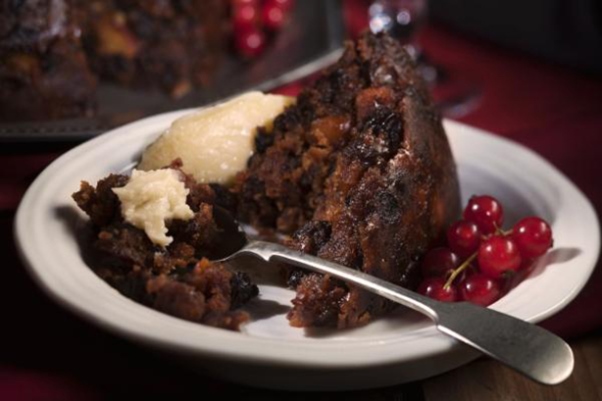Historical commentary. Religion was a major factor that influenced the customs of this popular dish. Before the Reformation, when Catholicism was the state religion, the Roman Catholic Church had decreed that puddings should be made on the 25th Sunday after Trinity and made with thirteen ingredients, symbolising Jesus Christ and his 12 apostles. This date became known as ‘Stir it up Sunday’ because each member of the family was required to stir the pudding before it was cooked. The last Sunday in November or first Sunday in December, was the time for baking puddings and cakes before Christmas.
It was during the early 17h century that plum pottages stopped being an everyday food because cooking it became a lengthy process (boiling for up to 9 hours) and could not be undertaken on a regular basis. Therefore, it became the tradition to eat it on special occasions on the Christian calendar.
Earlier during the 16th century, a different view of Christmas and its customs emerged and rapidly spread amongst non Catholics. The Western schism began in 1517 and gained momentum in England when Henry VIII broke away from the Catholic Church and became the Head of the Church of England in 1533.
In 1583 the English pamphleteer, Philip Stubbes, a Protestant, attacked the practices associated with Christmas in the book Anatomie of Abuses, after spending seven years travelling throughout the land and observing social practices. He wrote about Christmas: “That more mischief is that time committed than in all the year besides, what masking and mumming, whereby robbery whoredom, murder and what not is committed? What dicing and carding, what eating and drinking, what banqueting and feasting is then used, more than in all the year besides, to the great dishonour of God and impoverishing of the real.’”
When the Protestant Puritans came to power under Cromwell in the 1640s, they made an attempt to ban Christmas in 1656. They thought that Christmas was a pagan festival that had evolved from the Roman Saturnalia and they wanted to eradicate all traces of Catholicism along with the practices they considered unscriptural. They thought the day should be spent fasting instead of feasting and they also tried to ban the foods associated with Christmas, including the plum pottage and mince pies. The Puritans hated those foods because it was customary to present the priesthood in the Vatican with sweetmeats as symbols of devotion. Therefore, such practices the Puritans associated with Catholic idolatry.
During the next 150 years, meat and plums were gradually replaced by currants, raisins and other dried fruit that had become popular in England since 1592, when the Levant trading company were given exclusive trading rights by Queen Elizabeth I to trade in currants. However, although the ingredients changed over time, some form of alcohol was always added to the recipe to help in the maturation process.




